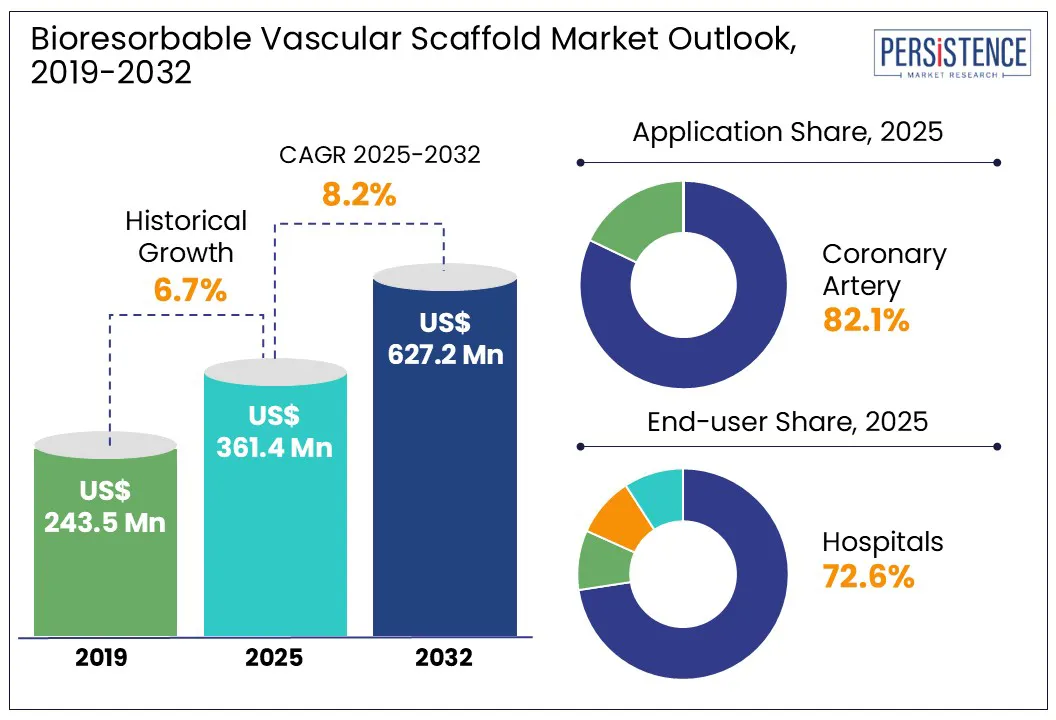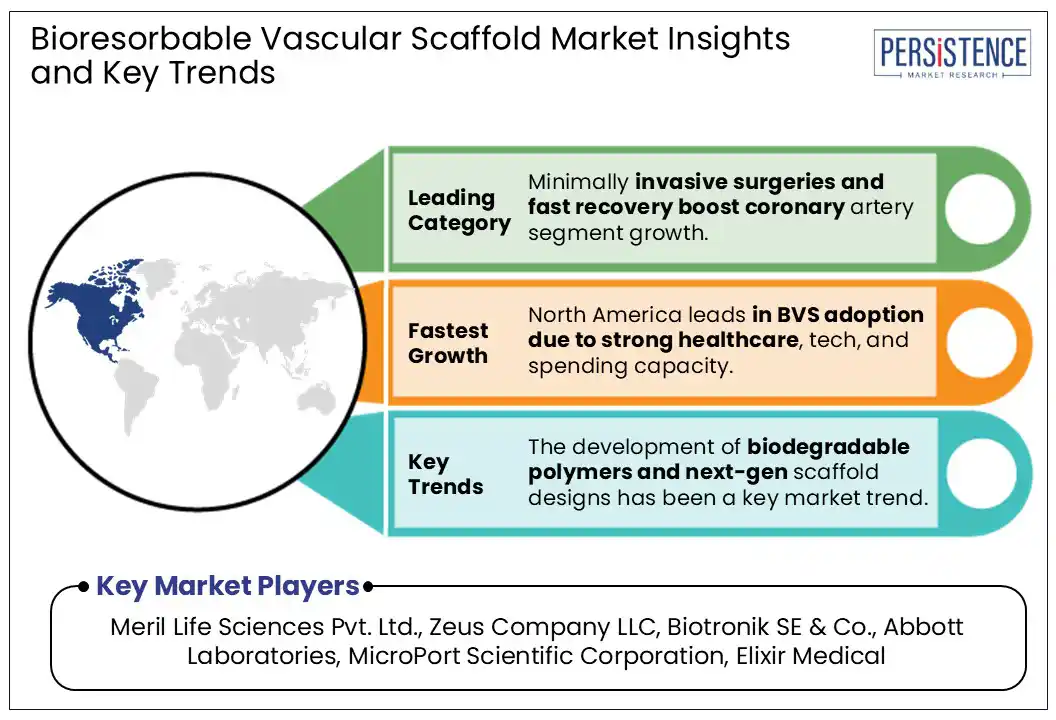ID: PMRREP34715| 192 Pages | 19 Jun 2025 | Format: PDF, Excel, PPT* | Healthcare

The global bioresorbable vascular scaffold market size is estimated to be valued at US$ 592.8 Million by 2032 from US$ 314.4 Million in 2025. It is expected to register a CAGR of 8.3% in the forecast period between 2025 and 2032.
Bioresorbable vascular scaffolds (BVS) have emerged as an innovative solution to traditional stents used in treating coronary artery disease (CAD). The BVS technology provides temporary support to the artery and then dissolves, allowing the vessel to regain its natural function. Next-generation bioresorbable scaffolds are being designed to better withstand vascular complications and adapt to individual patient anatomies. Further advancements in the field of interventional cardiology, driven by a paradigm shift toward personalized medicine, improved equipment manufacturing, and faster regulatory approvals, will fuel the bioresorbable vascular scaffold market growth in the forthcoming years.

Key Industry Highlights
According to a 2023 report released by the World Heart Federation (WHF), CVD killed over 20 million people worldwide in 2021, emerging as the leading cause of death globally. Moreover, the American Heart Association revealed in a 2024 report that around 5% of Americans aged under 20 suffer from CAD. Patients afflicted by CVD or CAD often seek low-risk treatments with faster recovery times. Minimally invasive procedures (MIS) fulfil this preference among heart patients, with bioresorbable vascular scaffolds providing an efficient alternative to traditional surgical techniques. The alignment between changing patient preferences and rapid advancements in interventional cardiology will propel the bioresorbable scaffolds market growth in the upcoming years. The incorporation of digital health solutions will also play a central role in the adoption of bioresorbable vascular scaffold in the near future.
Concerns surrounding the biocompatibility of bioresorbable vascular scaffolds arise from the uncertainty of the body’s response to the scaffold material. This response, in turn, is likely to affect tissue integration and the overall healing process. On the other hand, the material used needs to have sufficient mechanical strength to support the body’s vascular structure while it degrades at a controlled rate. Addressing these interconnected challenges requires huge upfront investments in research & development activities, which can prove to be a major hurdle in the growth of the BVS market.
The bioresorbable vascular scaffold industry is expected to make gains due to an increasingly favorable regulatory environment for innovative medical devices and procedures. Regulatory bodies are expediting the approval of new-age treatment options such as BVS, enabling quick market entry to health-tech companies specializing in cardiac products and services. Additionally, the market is set to benefit from significant investments being made in R&D activities in this field. For example, in May 2024, a California-based healthcare technology company called R3 Vascular, raised US$ 87 million to develop bioresorbable scaffolds to treat peripheral arterial disease. The BVS market is poised for speedy expansion as a result of these innovation opportunities.
Based on product, the bioresorbable vascular scaffold market has been divided into metal bioresorbable vascular scaffold and polymer bioresorbable vascular scaffold. The polymer BVS segmented is set to lead the product category with a share of 89.7% in 2025. Polymer-based scaffolds are gaining traction due to their superior biocompatibility and controlled degradation rates, which align with the body's healing process. Innovations in biodegradable polymers and scaffold architecture are enhancing performance metrics such as radial strength and flexibility, positioning polymer scaffolds as a key growth driver.
Based on application, the bioresorbable vascular scaffold market has been segmented into coronary artery and peripheral artery. The market share for coronary artery is anticipated to dominate the market during the forecast period with a positive CAGR through 2032. The emergence of CAD as a leading cause of death worldwide in recent years and the growing demand for minimally invasive surgeries with faster recovery periods are the two primary factors driving this segment. Moreover, advancements in bioresorbable vascular scaffolds have made them more efficient and safer, increasing their adoption among cardiac patients and healthcare professionals alike.
By end-user, the segmentation includes hospitals, ambulatory care centers, cardiac centers, and others. Among these hospitals are expected to showcase a leading CAGR through 2032, holding a major share in the bioresorbable vascular scaffold market. Hospitals are the most preferred locations for cardiovascular treatments due to the availability of healthcare professionals and advanced medical infrastructure.

North America dominates the bioresorbable vascular scaffold market and is expected to grow at a 7.70% CAGR through 2032. The region boasts a robust healthcare infrastructure, high spending ability, and strong healthcare expenditure, enabling swift adoption of next-generation medical technologies such as BVS. Additionally, rising incidence of CVD and CAD among the US population will further boost the regional market. Favorable regulations and heavy investments in healthcare R&D are also key factors driving the bioresorbable scaffolds market in North America.
East Asia Market is projected to secure a CAGR of 9.21% in the forecast period by 2032. The region’s increasing healthcare expenditure and advancements in medical technology drive demand for innovative cardiovascular treatments. Furthermore, growing awareness among healthcare professionals and patients about the benefits of bioresorbable scaffolds over traditional stents is accelerating the adoption.
Additionally, favorable government initiatives supporting the development of healthcare infrastructure and the rising incidence of cardiovascular diseases contribute to market growth. With expanding access to advanced healthcare facilities and a rise in an aging population prone to cardiac ailments, East Asia offers more opportunities for market expansion.
The global bioresorbable vascular scaffold market is competitive. Growing R&D investments to develop, launch, and expand the product portfolio is a key strategy observed in the last couple of years. The leading industry players are expanding their manufacturing capabilities and simultaneously their presence in the global industry.
The market is projected to reach US$ 314.4 million in 2025.
The rising incidence of cardiovascular disease and coronary heart disease, along with a growing preference for minimally invasive heart procedures, are the key market drivers.
The market is poised to witness a CAGR of 8.3% from 2025 to 2032.
An increasingly favorable regulatory environment for innovative medical devices and procedures, and significant investments being made in R&D activities, are the key market opportunities.
Meril Life Sciences Pvt. Ltd., Zeus Company LLC, and Biotronik SE & Co. are some key players in the bioresorbable vascular scaffold market.
|
Report Attribute |
Details |
|
Historical Data/Actuals |
2019 - 2024 |
|
Forecast Period |
2025 - 2032 |
|
Market Analysis Units |
Value: US$ Bn/Mn, Volume: As Applicable |
|
Geographical Coverage |
|
|
Segmental Coverage |
|
|
Competitive Analysis |
|
|
Report Highlights |
|
|
Customization and Pricing |
Available upon request |
By Product
By Application
By End-user
By Region
Delivery Timelines
For more information on this report and its delivery timelines please get in touch with our sales team.
About Author